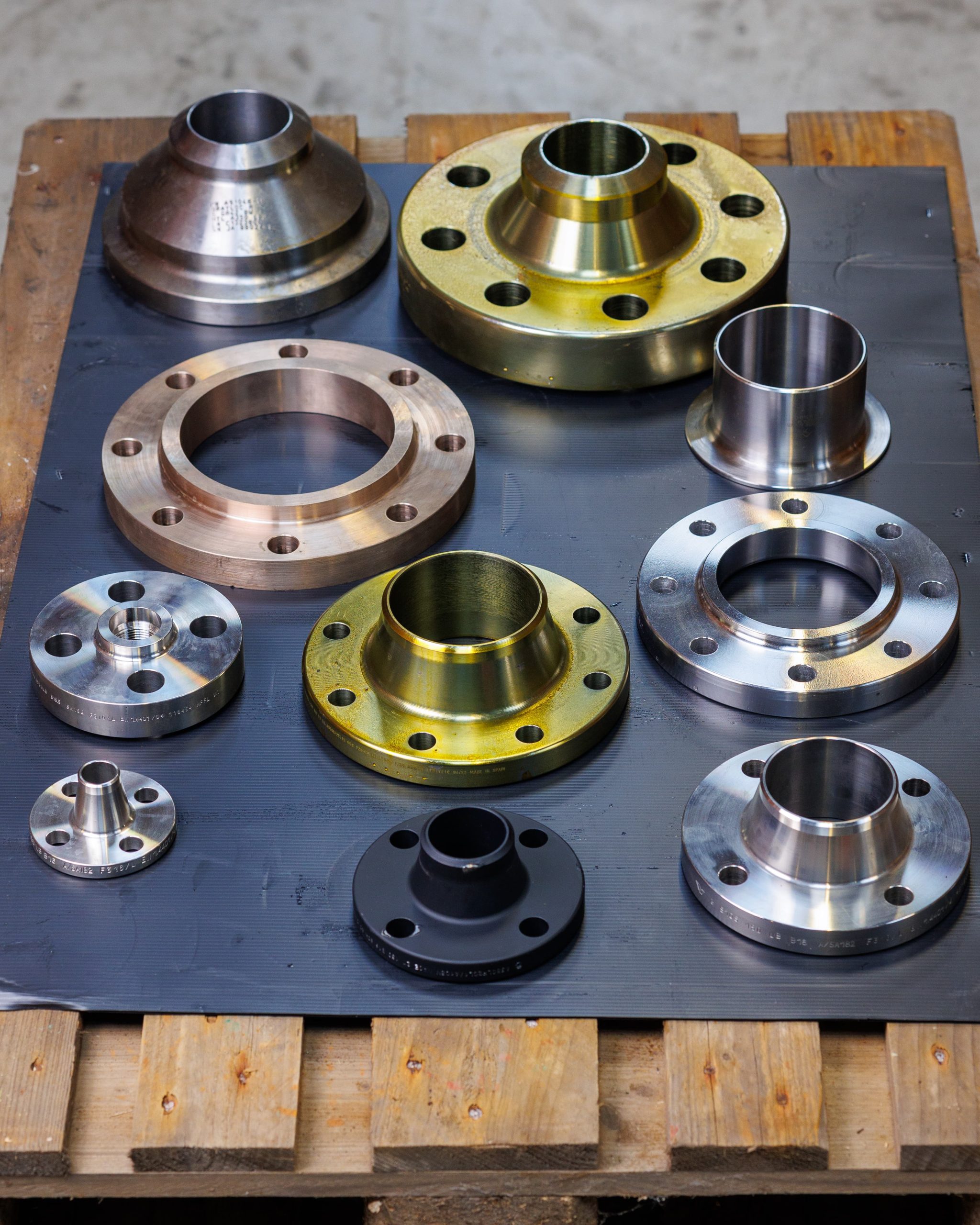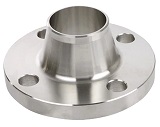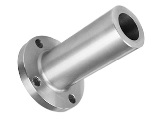HIGH QUALITY PRODUCTS
Flanges
Dimensional standards
Carbon and Low Alloy: ASTM A105N, ASTM A350 LF2

ANSI Flanges – Denmark
Carbon and Low Alloy: ASTM A105N, ASTM A350 LF2
High Yield: ASTM A694 F52, ASTM A694 F60, ASTM A694 F65
Chromium Molybdenum: ASTM A182 F1, F5, F9, F11, F22, F91
Austenitic Stainless Steels: ASTM A182 F304, ASTM A182 F316L, ASTM A182 F44
Ferritic Stainless steels: ASTM A182 F51, ASTM A182 F53, ASTM A182 F55
Duplex S31803, Super Duplex S32750/S32760
Copper Nickel: 90/10 + EEMUA 145
ANSI Flanges or ASME Flanges?
Some customers call us asking for ANSI Flanges and others call us asking for ASME Flanges. We even have customers calling us to ask if there is a difference between ANSI and ASME Flanges. In reality there is no difference. ASME is ‘The American Society Of Mechanical Engineers’ and ANSI is the ‘American National Standards Institute’. The ANSI standards (i.e. ANSI B16.5 or ANSI B16.47) are developed by ASME working under procedures accredited by ANSI and hence these standards are adopted by ANSI to become the standards for ANSI Flanges.
ANSI Flange Types:
- Welding Neck Flange
- Socket Weld Flange
- Threaded Flange
- Lap Joint Flange
- Blind Flange
- Orifice Flanges
- Spades / Spacers
- Spectacle Blinds
- Drip Rings
- Slip On Flange
- Flanged Olets
- Long Welding Neck
Specifications for ANSI Flanges
Flanges are specified by:
Size (NPS 2″, 4″ etc.) – NPS is Nominal Pipe Size
Rating Class (150# or 150lb, 300# or 300lb etc.)
Pipe Wall Thickness – where applicable (SCHEDULE 40, SCHEDULE 80 etc.)
Flange Facing (Raised Face, Ring Joint Face etc.)
Flange Type (Welding Neck Flange, Blind Flange etc.)
Flange Material (ASTM A350 LF2, ASTM A182 316L etc.)
Of course on a daily basis you would not need to write all these specifications to the letter when ordering ANSI Flanges at Esbjerg Oiltool A/S. You could just write 2″ 150# SCH.40 RF WN A350 LF2 and we would know exactly which flanges you need. BTW: We have those in stock.
Various types of ANSI Flanges

Welding Neck Flange / Weld Neck Flange / WN Flange
Welding Neck flanges are designed to be welded directly to the abutting pipe forming an unrestricted flow of the media running in the pipe. The dimensions of the Welding Neck Flange will almost always match the pipe it has to be welded to in terms of Size and Wall Thickness/Pipe Schedule – See Nominal Pipe Sizes here. ANSI WN Flanges can be delivered with various Flange Facings i.e. Flat Faced (FF), Raised Faced (RF), Ring Joint (RTJ) to match various types of ANSI Gaskets.

Blind Flange
As you will notice ANSI Blind Flages are the only ones of the flanges that do not have a hole in the middle of the flange. Blind Flanges are used to blind off the access to a piping spool and are bolted to i.e. a Welding Neck flange via the correct fasteners. In that way no welding is needed to install the blind flange which also makes them easy to remove for inspection of the inside of the piping system or pressure vessel.

Socket Weld Flange
Socket Weld Flanges are machined to have a socket in the flange matching the pipe it has to be welded to. The pipe is inserted into the socket of the flange and is secured by a single fillet weld between the pipe and the flange. Socket Weld Flanges should normally not be used for piping systems carrying highly corrosive fluids due to the ‘open’ gap between the flange and the pipe.

Slip On Flange
ANSI Slip On Flanges are designed with a bore slightly larger than the matching pipe allowing for the flange to be ‘slipped on’ to the pipe. The Slip On Flange is then attached to the pipe using 2 fillet welds. One on the inside (bore) and one on the outside of the flange. Dimensions and tolerances of Slip On Flanges can be found in ANSI/ASME B16.5.

Threaded Flange / NPT Flange
ANSI Threaded Flanges have a female NPT thread in the bore of the flange and can thus be screwed onto a matching pipe with an outside male NPT (To ASME B1.20.1) thread. In this way the flange can be installed without the need of welding which makes them useful in areas with explosive gasses. ANSI Threaded Flanges can be delivered in sizes from 1/2″ to 4″.

Lap Joint Flange
ANSI Lap Joint Flanges are the only type of flanges that does not come in contact with the pipe as they are always used in connection with a stub end. The stub end will be welded to the pipe and the Lap Joint Flange will be located on the back of the stub end. This also means that the flange can rotate freely on the pipe for easy Studbolt assembly. Lap Joint Flanges in connection with Stub Ends can save cost as the Lap Joint Flange does not come in contact with the media in the pipe and thus can be produced in a lower material grade.

Long Welding Neck Flange / LWN / Straight Hub Welding Flange
Long Welding Neck Flanges or as they are more correctly named in ANSI/ASME B16.5 Straight Hub Welding Flanges are very similar to the Welding Neck Flanges but have an extended neck with a uniform diameter on the outside of the neck. According to ANSI B16.5 the length of the hub should be 9″ (229 mm) for NPS 4″ and smaller and 12″ (305 mm) for NPS larger than 4″. However other length can be ordered by the customer.
Find the correct studbolts / fasteners for your ANSI/ASME Flanges
In order to determine the correct size of studbolts to use for your ANSI/ASME Flanges you need to know the size (meaning the matching pipe size) of the flange, the pressure rating of the flange (150lbs, 300lbs etc.) and the facing of the flange. The facing can either be Raised Faced (RF) or Ring Type Joint (RTJ). Download our datasheet Studbolt Sizes for ANSI/ASME Flanges. In the datasheet you can now find the correct studbolts by looking at the correct pressure rating (class) of the flange, the Nominal Pipe Size (NPS) and the type of flange facing.
Example: For a 4″ class 300 ANSI/ASME Flange with an RTJ type flange facing 8 pcs. 3/4″ (M20 for metric) studbolts with a length of 130 mm are needed. For the same flange as Raised Face the studbolts should be 115 mm.
Feel free to link to our datasheet with ANSI/ASME Studbolt Sizes from your own website if you want to